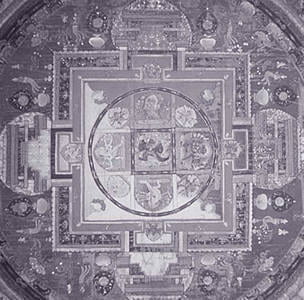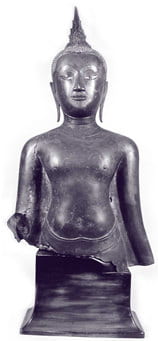Visions of Enlightenment: Understanding the Art of Buddhism
September 29, 2002 – January 12, 2003
Related Exhibit:
Sacred Stitches: Tibetan Buddhist Images Pieced in Silk by Leslie Rinchen Wongmo
September 29, 2002 – February 16, 2003
Visions of Enlightenment explores the basic iconography and symbolism of this religious tradition, using Buddhist imagery from throughout Asia. The paintings, sculptures, textiles, and ritual objects in the exhibition are drawn in part from the museum’s rich collection of Buddhist art, as well as from several local private and museum collections.
In the Buddhist faith, the goal of the practitioner is to attain spiritual enlightenment or spiritual perfection, thus freeing the soul from an endless cycle of birth, death and rebirth. The art of Buddhism has long played an important role in assisting followers in this pursuit. Sculptural and painted images of Buddhas, bodhisattvas, and deities, in particular, have served to aid Buddhist practitioners with meditation, prayer, and self improvement. Over the centuries, the iconography of Buddhism has become increasingly elaborate as Buddhism itself grew more complex and spread throughout the world.
The exhibition is organized into four sections dealing with four aspects of Buddhist art.
The Perfected One: The Buddha The Buddha was a prince who lived in northern India about 2,500 years ago. He gave up his life of luxury to seek a true understanding about life and suffering. He achieved this understanding, or spiritual enlightenment, and then spent the rest of his life spreading his teachings throughout India. In the Buddhist faith, the Buddha is not a god, but a being who has attained a state of spiritual perfection, and images of the Buddha are a reminder that we all have the potential to become Buddhas. The Buddha is usually depicted wearing the robes of a monk and appears calm and free from the troubles of this world.
Compassionate Beings: The Bodhisattvas Bodhisattvas are compassionate beings who are close to achieving their own enlightenment, and thus Buddhahood, but postpone it in order to help others attain enlightenment. Unlike the Buddha, who has achieved release from this world, bodhisattvas remain in this world and offer support to those seeking enlightenment. They are usually depicted in graceful, animated poses and wear crowns and jewelry to represent their continued presence in this world.
Upholders of the Buddhist Law: Guardians, Deities and Holy Men The Buddhist pantheon also includes various deities who protect the Buddhist teachings, or Law, and holy men who spread these teachings. The section includes guardian figures, often shown as fierce deities with grimacing faces and wearing armor. Also included are several peaceful and wrathful Buddhist deities. Wrathful deities, often depicted with fangs and bulging eyes and carrying weapons, are not harmful to followers but instead, protect them against jealousy, anger, and other destructive forces that hinder progress towards enlightenment. Images of some of the Buddhist holy men and teachers who helped to spread the Buddhist faith throughout Asia are also featured.
Objects and Texts for Ritual and Meditation Many objects, images, and texts are used in the meditation, prayers and rituals of the various sects of Buddhism. Some of these objects, such as the incense burners, prayer beads, bells, and water vessels, are used throughout Asia in rituals. Others, such as vajras, mandalas, and other images used for meditation and visualization practices, are employed in the rituals of particular sects. Also featured in the exhibition are two Buddhist altars, one from Tibet, the other from Japan, to show how some of the objects are employed by practitioners of Buddhism.
A selection of photographs of Buddhist life by Don Farber will be on display in the Foyer to the Auditorium.
This exhibition has been generously underwritten by Raymond and Virginia Atchley, David and Margaret Barry, Paul and Georgianna Erskine, Ralph and Angelyn Riffenburgh, and Wells Fargo.
ONLINE EXHIBITION— Visions of Enlightenment: Understanding the Art of Buddhism
(includes images, essays, teacher resources, maps, and glossary)

